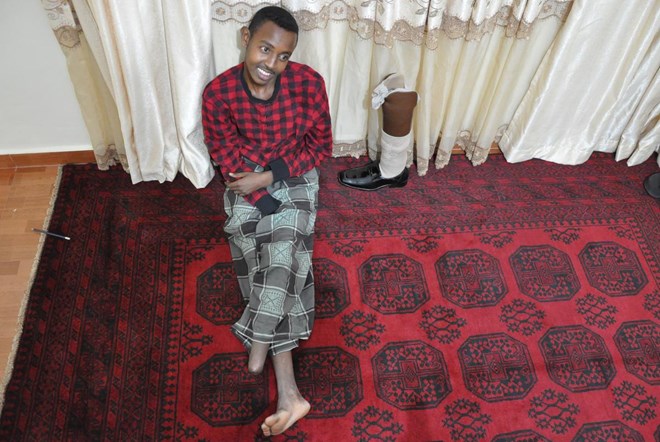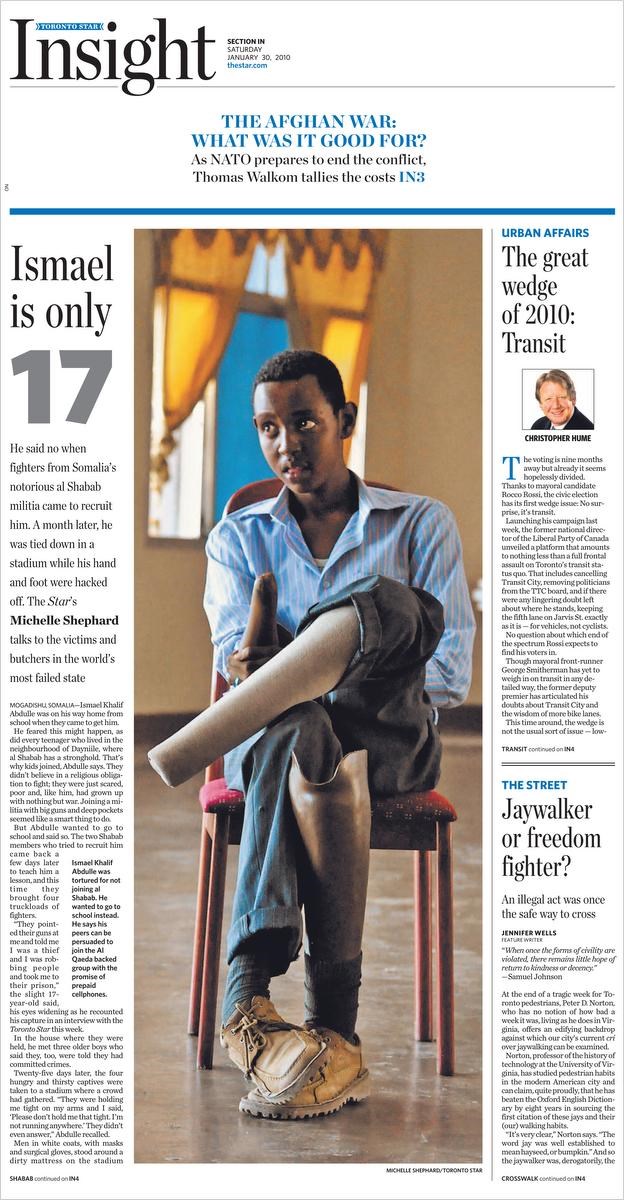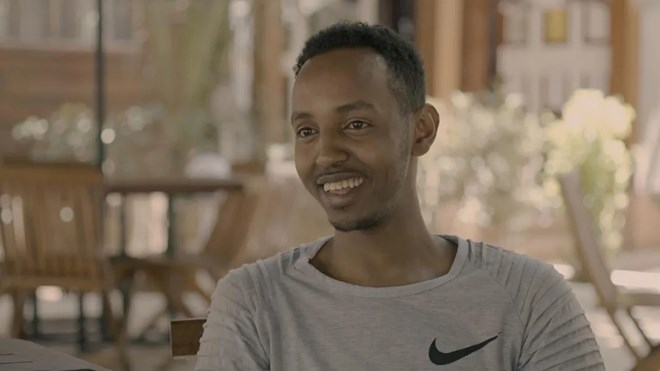
Saturday September 24, 2022
By Donovan Vincent
A story from 2011 about a Somalia teenager was later revealed to have some crucial details wrong.

Ismael Abdulle in Kenya. Toronto Star
It was an incredibly powerful story that deeply touched Star readers and significantly changed the life of a young man in Somalia.
But an important detail was false.
As a result, we failed to present accurate facts, and we owe it to our readers to set the record straight and try to get to the bottom of how it happened.
In January 2010, Michelle Shephard, then a national security reporter for the Star, travelled to Mogadishu to write about 17-year-old Ismael Abdulle, who told her that the year prior he had been captured by members of Somali terrorist group al-Shabab on his way home from school.
Abdulle told Shephard, a seasoned reporter who had written extensively on security issues since the attacks of Sept. 11, 2001, in the U.S., that al-Shabab — fundamentalist insurgents who later joined forces with al-Qaida — tried to recruit him but punished him a few days after he told members of the group he wanted to stay in school and wasn’t interested in joining their cause.
When Shephard met Abdulle for the interview, he was missing his left foot and right hand, limbs the extremists cut off as part of their extreme interpretation of sharia. It was a lesson for turning them down, Abdulle told Shephard.
The boy’s limbs and those of three other young men were hung in the square by al-Shabab as a warning, he said.
After being held as prisoners by the group, the young men managed to escape, Abdulle told her.
Moved by the young man’s plight, Shephard took a photograph of him, an arresting and shocking image of him sitting cross-legged with his prosthetic leg in front, his amputated foot visible, a vacant, helpless expression on his face as he sat on a chair inside a Somali government compound.
That photo and accompanying story, part of a larger feature-length article on the violent scourge of al-Shabab in Somalia, moved many of our readers.
The story set off a chain of events. Members of the Somali diaspora in Toronto, horrified and deeply saddened by the photo and story, came together to form a group named “Project Ismael.”

They made phone calls, reached out to lawyers and immigration activists in a desperate bid to help the young man.
Several months after the story was published, a Somali Canadian helped get Abdulle to Kenya and, in 2011, Abdulle was accepted into Norway after becoming a United Nations refugee.
Shephard tracked these developments in a series of followup stories for the Star.
But in 2019, during the shooting of Shephard’s soon to be released National Film Board and TVO documentary about Abdulle, came a stunning admission.
Abdulle, tormented by guilt, admits he lied to Shephard.
He confessed that he was in fact a thief when al-Shabab caught up with him, just as the terrorist group had claimed publicly at the time. He was armed with a pistol when they grabbed him, he said.
Abdulle and the other boys didn’t escape from al-Shabab after the amputations. They were let go — another lie, he said.
Why did he misrepresent the facts? Abdulle says he made up the story because he wanted to find a westerner to help him get to Europe. That’s when Shephard came along.
He told her he created the story at the time to make himself look “innocent.”
An explosive admission given all that happened to him after he told her his original story.
We at the Star sincerely apologize to our readers for publishing false information pertaining to this case.
In the Star’s lengthy journalistic standards guide, the blueprint for how we operate as a news organization, you’ll find this line: “Good faith with the reader is the foundation of ethical and excellent journalism. That good faith rests primarily on the reader’s confidence that what we print is correct.”
We can’t lose that faith. It’s our duty to print the truth and be able to stand behind what we say.
The guidelines also say “every effort must be made” to ensure that everything we publish is accurate.
How could the Star have prevented Abdulle’s lie from getting into print?
I spoke with Shephard at length about this a few days ago.
Shephard, who left the Star in 2018, is a highly accomplished journalist, the recipient of several journalism awards, an author and award-winning filmmaker who has travelled to more than 20 countries as part of her work.
During our conversation she explained how she received the tip about Abdulle’s story from one of her reliable sources.
In terms of fact checking the story after the interview, there were limitations, she told me. For one, she was operating in a conflict zone, where moving about freely wasn’t an option. It just wasn’t safe.
She was at the “mercy” of her escorts, African Union peacekeepers, and unable to work independently, to door-knock and try to verify Abdulle’s story.

Journalist and filmmaker Michelle Shephard walks with Ismael Abdulle in Mogadishu. COURTESY OF THE NATIONAL FILM BOARD OF CANADA, 2021
“All I had in terms of a face-to-face (with Abdulle) was about 90 minutes with him to tell that story, get a photo and then I was out. And my escorts said we couldn’t go back,” Shephard said.
Later in our conversation she said: “Of course we have to use due diligence and fact checking. But especially in a conflict zone you only can do it to a certain degree.”
In fact, in the first story about Abdulle, Shephard laid out the challenge she faced getting at the truth: “Part of the problem is that the boys’ stories are difficult to verify. Some reports state that they were actually once members of al-Shabab and tried to defect.”
She noted to me that on the security beat she was always distrustful of people in authority from organizations like the Pentagon, the Canadian Security Intelligence Service (CSIS) and the RCMP and would “go hard on them to ensure accuracy.”
But there was Abdulle sitting before her saying he’d had his limbs cut off by al-Shabab, a group angry that he didn’t join them. And there he was, with missing limbs, she said.
“Why would I think to press, to re-traumatize a 17-year-old who had gone through this?” she said.
She later added: “It’s arrogant to fly in as the foreign correspondent to say, ‘Oh, really? Is this really what happened to you?’”
But it wasn’t just Shephard that Abdulle told his story to, she said. She knows several people in Mogadishu, many of them there from Canada, including in the Somali government.
“Lots of people in the (Somali) diaspora who have family in Mogadishu all had heard the same story. Nobody raised any doubt,” she said.
Nevertheless, there was an institutional failure by the Star.
Should Shephard have been pressed by her editors before the story was published?
Shephard wrote that Abdulle’s and the other boys’ stories were difficult to confirm, a potential red flag that editors missed.
I looked into whether Shephard’s editors asked her to check the veracity of Abdulle’s story.
Shephard’s first story on Abdulle ran long ago and those editors who worked on it have since left the Star. Memories fade.
Lynn McAuley, former associate editor for the Star, was in charge of the newspaper’s foreign coverage when Shephard wrote the latter stories about Abdulle’s time in Norway.
In an interview, McAuley said she believes Shephard did everything she possibly could, given the challenges she faced in the war zone in Somalia, to verify Abdulle’s story.”
“These are circumstances that I have seen (reporters face) over and over again in many conflict zones and I know how hard reporters work to corroborate those stories. Just getting the other side of the story doesn’t mean you’ve proven the truth,” McAuley says.
The case is a cautionary tale for all journalists.
Whether it’s a war zone or any other challenging circumstance, journalists need to find ways to confirm whether the details they’ve gathered are true. And if there’s a doubt, there’s always the option of simply not publishing.
No matter how sympathetic the victim, reporters still need to ask probing questions and maintain a level of skepticism. In cases involving victims of torture, for example, we have to balance that skepticism with compassion.
It isn’t an easy task.
One other element of the saga leaves me unsettled. Shephard learned of the lie in the fall of 2019, as the documentary shows, yet she is only coming forward to the Star now.
She told me she held off coming forward sooner over concerns about how Abdulle’s admission to her and the release of that information to the public would impact his mental health.
There was no requirement whatsoever for her to come forward sooner, given she was no longer an employee of the Star and was working on her documentary with the National Film Board and TVO, entities separate from this newspaper.
Still, I wish she was able to inform the Star earlier.
Our readers needed to know.